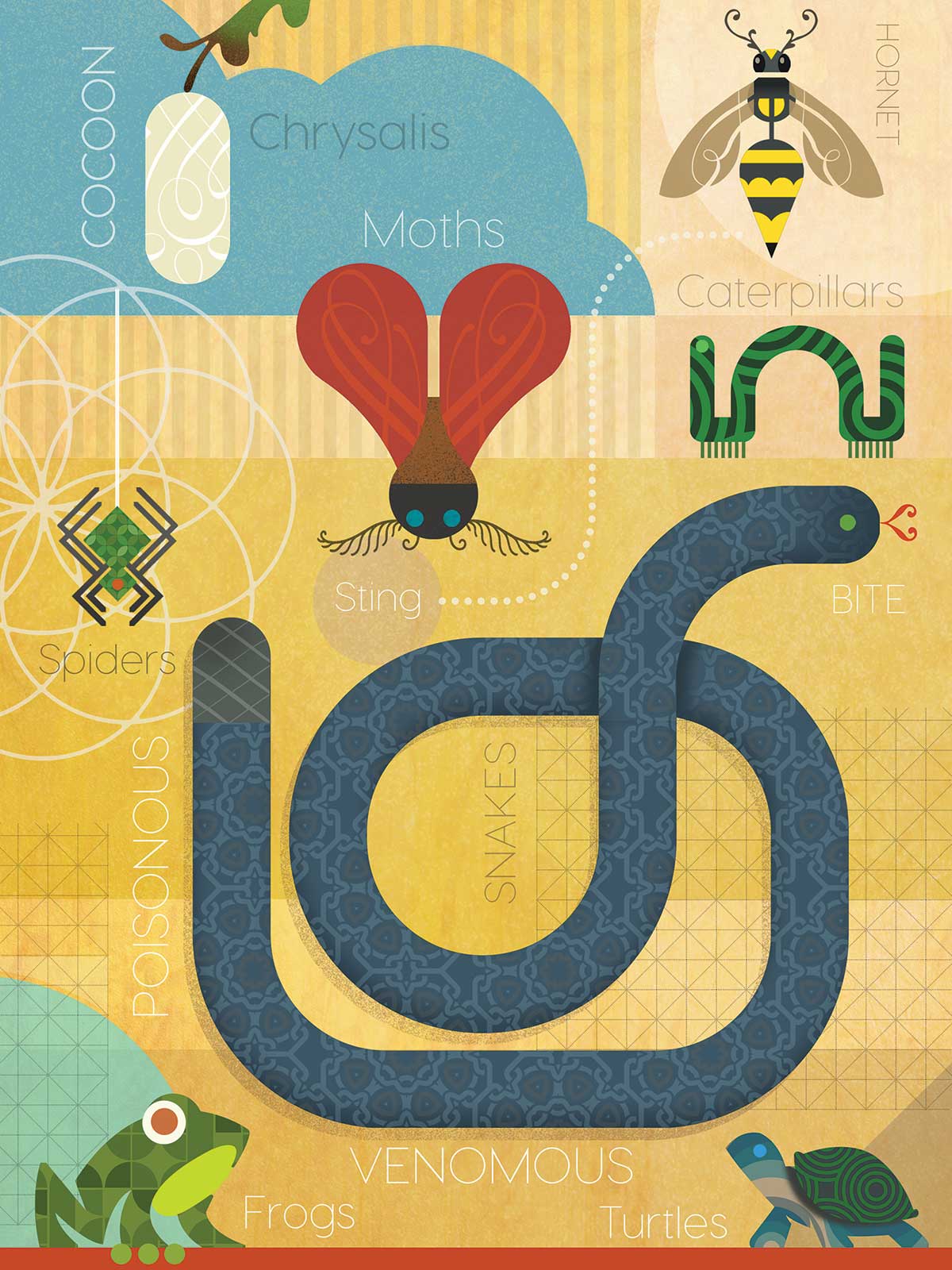A photograph taken six years ago captured me pointing to a warning sign posted on a Galveston beach. The sign read: CAUTION—POISONOUS SNAKES IN DUNES. The choice of adjective still irks me. But I understand. I, too, made the same mistake before I learned my first naturalist lesson. Since then, I’ve learned many more.
Poisonous or venomous? The Merriam-Webster Dictionary defines poison as “a substance that through its chemical action usually kills, injures or impairs an organism.” Venom is “a toxic substance produced by some animals … that is injected … chiefly by biting or stinging and has an injurious or lethal effect.” Poison must be consumed whereas venom must be injected.
Bite or sting? A venomous bite happens when a creature sinks its fangs into a victim and injects venom through special structures in its mouth. Stings occur when a creature jabs venom into a victim through its stinger. Spiders and snakes bite; bees and wasps sting.
Bee or wasp? To tell the difference, look at the body. Honeybees, carpenter bees and bumblebees have plump, fuzzy bodies with thick legs. Honeybee colonies generally build their honeycomb nests inside tree cavities or human-made boxes. They sting once, then die. Carpenter bees and bumblebees, which respectively nest in wood and underground burrows, can sting but rarely do. The majority of native bees in Texas are solitary, meaning they nest alone.
Wasps have slender, smooth bodies with narrow waists, skinny legs and bright markings. They usually build papery nests and can sting repeatedly. Examples include yellow jackets and paper wasps. As for hornets, they’re larger than wasps. Texas has only one kind—the bald-faced hornet, which is actually a yellow jacket. Aren’t common names confusing?
Bug or insect? First, all bugs are insects. But not all insects are bugs. Bugs are classified as insects because they all have six legs, segmented bodies and exoskeletons. But not all insects have a mouth part called a proboscis. Only true bugs do. Examples include stink bugs, leafhoppers, cicadas, aphids and bedbugs. True bugs also hatch from eggs as tiny versions of their adult selves. Insects, such as butterflies, ants, flies and beetles, go through the stages of egg, larva and pupa.
Butterfly or moth? Most butterflies fly during the day. They’re usually brightly colored and have slender, smooth bodies with club-tipped antennae. At rest, they hold their wings up. In contrast, most moths fly at night. They’re usually drab in color and have fuzzy, thick bodies with feathered or tapered antennae. At rest, most fold their wings back.
Chrysalis or cocoon? Butterflies and moths pupate. That is, both metamorphose from caterpillars (larvae) into pupae, which then transform into adults. Most moth caterpillars spin a silk case called a cocoon around themselves. Inside, they pupate and emerge as adults. Butterfly caterpillars attach themselves to a safe place. Then they wiggle out of their caterpillar skin, leaving behind a smooth chrysalis that hardens and protects the pupa inside. Later, an adult butterfly breaks out of the chrysalis.
Spider or daddy longlegs? Another taxonomy lesson first. Spiders and daddy longlegs both have eight legs and exoskeletons. That makes them arachnids. The two differ in that spiders have two body parts and spin silk; daddy longlegs (also called harvestmen) have one body part and spin no silk. Unlike spiders, they have no fangs or venom.
Turtle or tortoise? All tortoises are turtles. But not all turtles are tortoises. Both are classified in a group of hard-shelled animals known as turtles. True turtles live in or near water and most have webbed feet and a smooth shell. Not so for tortoises, which have stumpy feet and live exclusively on land. Tortoises eat only plants; turtles eat plants and animals.
Frog or toad? Look at the skin. Generally, toads have bumpy, dry skin and don’t need to live near water. Frogs have smooth, moist skin and require a watery habitat. Both live in my yard. Gulf Coast toads, warty and blackish gray, show up in my flower beds sometimes. They’re harmless. Not so for the resident Rio Grande leopard frogs. To my dismay, they hang out in my stock tank and trample the aquatic plants, but they can’t hurt a human.
What’s a gardener to do? That’s a lesson I haven’t learned yet.



